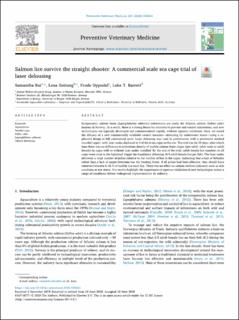| dc.contributor.author | Bui, Samantha | |
| dc.contributor.author | Geitung, Lena | |
| dc.contributor.author | Oppedal, Frode | |
| dc.contributor.author | Barrett, Luke T. | |
| dc.date.accessioned | 2020-10-14T11:42:44Z | |
| dc.date.available | 2020-10-14T11:42:44Z | |
| dc.date.created | 2020-08-03T12:45:32Z | |
| dc.date.issued | 2020 | |
| dc.identifier.citation | Preventive Veterinary Medicine. 2020, 181 1-6. | en_US |
| dc.identifier.issn | 0167-5877 | |
| dc.identifier.uri | https://hdl.handle.net/11250/2682798 | |
| dc.description.abstract | Ectoparasitic salmon louse (Lepeophtheirus salmonis) infestations are costly for Atlantic salmon (Salmo salar) farmers in Norway. As a result, there is a strong desire for solutions to prevent and control infestations, and new technologies are typically developed and commercialised rapidly, without rigorous validation. Here, we tested the efficacy of a new commercially available control measure—delousing by underwater lasers—using a replicated design at full commercial scale. Laser delousing was used in combination with a preventive method (snorkel cages), with laser nodes deployed in 3 of the 6 sea cages at the site. The trial ran for 54 days, after which time there was no difference in infestation density of mobile salmon louse stages (pre-adult, adult male or adult female) in cages with or without laser nodes installed. By the end of the trial, adult female lice numbers in all cages were close to the legislated trigger for mandatory delousing (0.5 adult female lice per fish). The laser nodes delivered a large number of pulses relative to the number of lice in the cages, indicating that a lack of lethality rather than a lack of target detection was the limiting factor. If all pulses had been effective, they should have removed between 4–38 % of mobile lice each day. There was no effect on salmon welfare indicators such as skin condition or eye status. Our results highlight the importance of rigorous validation of new technologies across a range of conditions before widespread implementation by industry. | en_US |
| dc.language.iso | eng | en_US |
| dc.title | Salmon lice survive the straight shooter: A commercial scale sea cage trial of laser delousing | en_US |
| dc.type | Peer reviewed | en_US |
| dc.type | Journal article | en_US |
| dc.description.version | publishedVersion | en_US |
| dc.source.pagenumber | 1-6 | en_US |
| dc.source.volume | 181 | en_US |
| dc.source.journal | Preventive Veterinary Medicine | en_US |
| dc.identifier.doi | 10.1016/j.prevetmed.2020.105063 | |
| dc.identifier.cristin | 1821307 | |
| dc.relation.project | Norges forskningsråd: 294730 | en_US |
| dc.relation.project | Norges forskningsråd: 267800 | en_US |
| cristin.ispublished | true | |
| cristin.fulltext | original | |
| cristin.qualitycode | 2 | |
